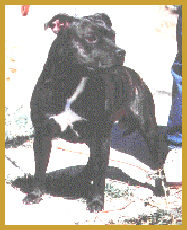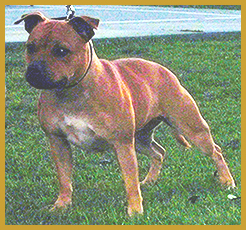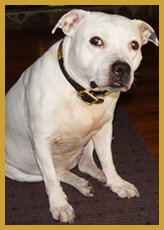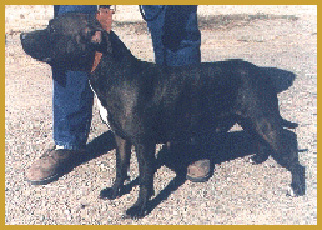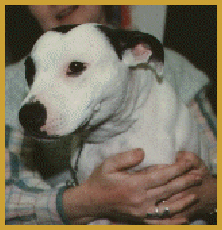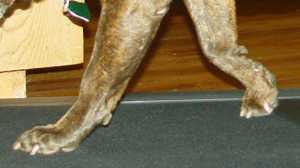Eliminating Genetic Diseases in Dogs:
A Buyer's Perspective
Author
by Gary F. Mason
gmason@ileaf.com
Copyright 1995 Gary F. Mason. All rights reserved. However, you are encouraged to copy and distribute this article for non-commercial use with the following restrictions: You may not modify the article in any way. You must include the entire article including the copyright notice. You may not charge any fee for use, copying, nor distribution of the product with the following exceptions: Non-profit organizations may charge a nominal fee (not to exceed $5.00) until and unless notified by the author this is not the case.
QUICK INDEX:
Introduction | Goal of the Effort | Scope of the Effort | Description of the problem | Technical Obstacles | The Human Component | An Approach to the Problem | Basic Education | Genetic Information Sharing | Preregistration Testing | Show Validation | Modification of Breed Standards | Registration Organizations | Health Related Organizations | Conclusion | Selected References
Introduction
This paper is the first product of an effort I have undertaken that was prompted by the discovery that our five month old Scottish Terrier suffered from Type III von Willebrand's Disease (vWD). The existence of this genetic bleeding disorder was unknown to us until he suffered a near fatal bleeding episode for no apparent reason. Subsequent treatment and testing revealed that he was affected with vWD.
We were quite naive - as I suspect many people are - when we bought our dog. Both of his parents were AKC registered, which we assumed meant that he was a healthy dog from healthy stock. In fact, prior to discovering his affliction, he too was registered (though we could have registered him even after discovering his malady). We have learned the hard way that “having papers” means very little, if anything, about the genetic health of a purebred dog.
This experience convinced us that dogs, and those who own them, should not have to live under the conditions dictated by genetic diseases. This is especially true since in the main they could be prevented. Our dog's disease has generated a lot of additional expense and worry which might have been avoided by a properly designed and managed breeding program. It has also become clear to us that prospective buyers should be better educated about the world of dogs before they make an investment that could lead to considerable extra expense, and worse, the heartbreak of losing a beloved friend too early.
This effort has no funding or sponsorship from any organization or other individuals. We neither breed nor show dogs, and have no plans to do so in the future. This is a personal attempt to contribute to the identification of, the development of tests for, and the progress of efforts toward the eradication of genetic diseases in dogs.
This article is intended to be an objective exposition on the subject of genetic diseases in domestic dogs. It is of the utmost importance that the information presented be as neutral as possible so as to encourage all interested parties to engage in productive dialog. No attempt will be made to attach any measure of goodness or acceptability to one view of an issue over another. It is hoped that this approach will enable synergies to be created by joint activity among and between parties interested in improving canine genetic health.
While no one is intentionally being eliminated from the target audience, the specific constituencies being addressed are breeders, breed clubs, dog registration organizations, prospective dog purchasers, researchers, and veterinarians.
Goal of the Effort
The goal of this effort is to provide assistance to any and all concerned parties in hopes of making progress toward the elimination of genetic diseases in dogs, and to generate additional interest in that effort. To that end, it is intended to:
Educate the audience on the subject of genetic diseases in dogs. Present a brief summary of some of the research and other activities currently underway which are working toward the elimination of genetic diseases in dogs. Suggest some options and approaches which can be examined with regard to their effectiveness in reaching this goal, in both the short term and the long term. Foster open dialog and cooperation among and between all interested parties.
Scope of the Effort
Although primarily terrier breeds are referenced here, this effort is not limited to any specific diseases or breeds. On the contrary, it is intended to encompass the widest range of both. It is hoped that in this way, the largest possible group of people will be induced to participate, and the broadest view of the subject will be developed.
This document is a first step, and proposes to use Type III von Willebrand's Disease in the Scottish Terrier as the example around which to build a framework for further efforts. The current level of knowledge about this disease is extensive, and indicates that this disease, in this breed, presents one of the simplest cases of genetic disease in the dog. Even if this proves to be true, vWD still offers a formidable set of challenges to the community committed to its eradication. But as a relatively simple example, it provides the opportunity to “start small”. The framework developed for attacking vWD could be used as the starting point for more elaborate requirements which would be dictated by more complex diseases.
Description of the Problem
Many diseases in the domestic dog are genetic in origin. Examples are vWD, Collie Eye Anomaly, portosystemic shunt, hemophilia, Scottie Cramp, hip dysplasia, Legg/Calv Perthes, medial patellar luxation, and craniomandibular osteopathy (CMO) -- the list is very long. So far, over five hundred genetic diseases have been identified in purebred dogs, and over a hundred in mixed breeds. They can affect conformation, health (virtually all systems in the body are subject), and temperament. In Scotties alone there are 36 identified genetic diseases, with similar numbers affecting each of several other terrier breeds.
There is a great deal of scientific research being performed on the identification of the specific causes of genetic diseases. Because some of the diseases exhibited by dogs are also evident in humans -- vWD is the most common human inherited blood disease -- some benefit could derive from canine research which would be of use in pursuing the human form of the same, or related, diseases.
Technical Obstacles
“There are no more easy problems.” Anonymous
The need for accurate definition of the mode of inheritance - The underlying causes of genetic diseases can be very complex. Efforts are underway to identify and isolate specific genes, and combinations of genes, related to various diseases. But it will probably be a very long time before most have been isolated. The research process is costly and very time consuming.
Variation in the expression of the disease - Genetic diseases which appear to be identical across breeds may in fact be caused by different genetic conditions. For example, vWD is believed to exemplify one mode of inheritance in Scottish Terriers, and another in German Shorthaired Pointers.
The absence of accurate tests - Some genetic characteristics can be determined by observation, but more frequently tests are necessary to identify specific genetic diseases. There are currently two tests for vWD, one more recent (and accurate) than the other. They test for the same constituent in the blood, but use different testing techniques. These tests are based upon measuring the quantity of a specific chemical in the blood, and while the test itself is very good, the results are subject to substantial variation based upon the collection and handling of the test samples. And there can be major variations in the amount of the chemical present in the animal due to its condition at the time of sample collection. Other genetic diseases depend upon other methods for their diagnosis. These include X-ray, physical manipulation, and other techniques. Testing for recognized genetic markers, or the genes themselves, will offer a virtually foolproof method for diagnosis. When a definitive test is developed for any disease, there should be no reason to ever produce a puppy adversely affected by that disease.
The Human Component
Any attempt to address the genetic disease problem in dogs must take into account the human component. People breed dogs for many reasons. While there are exceptions to every rule, most breeders of pedigreed dogs do seem to have the animals' best interests at heart. In the main, the production of dogs with genetic diseases today is not done out of malice, but out of ignorance due to a of lack of historical genetic information.
But there are other forces at work as well. Many dogs are shown at events sanctioned by various registration groups. Breeders of winning dogs earn the respect of their peers and others, and that respect can lead to enhanced benefits to the breeders. Within this environment, other benefits can also be accrued from breeding winning dogs. These include improving the breed; gaining personal satisfaction; and commanding higher prices for puppies bred from the winner's bloodlines.
For genetic diseases to be eliminated, they should be given at least as much weight as the other factors considered when breeding a dog -- principally conformation and behavioral traits. For any plan to be successful would probably require that these benefits remain achievable at current rates or better. The incentives provided for the breeding of dogs without genetic diseases should be at least as good -- probably better -- than exist today.
An Approach to the Problem
Since genetic diseases are passed to subsequent generations by parents who contribute the causal factors contained within their own genetic makeup, one point regarding this problem is fundamental:
The elimination of genetic diseases can only be accomplished through selective breeding.
The problems lie in determining how to identify the diseases' causal factors in dogs; in understanding when not to breed them; and in the implementation of selective breeding programs based upon these factors. Some of the avenues to be investigated include:
Basic Education
First and foremost in solving any problem is ensuring that everyone involved understands it. While genetics can be a very complex technical subject, the basic information required to make progress toward the elimination of genetic disease by developing an effective breeding program is within the reach and understanding of everyone concerned.
Breeders should understand the implications of genetic diseases recognized as affecting their breeds, and take steps to breed only those dogs that will minimize the propagation of unwanted characteristics.
Prospective buyers should be made aware of the genetic diseases related to the breed they are considering. And they should learn to ask that test results or genetic histories for the animals they are planning to purchase be explained to them.
Veterinarians should be able to recognize genetic diseases, and inform owners, breeders, and prospective breeders of their presence in dogs they examine and treat.
A general information publication on genetic diseases in all dogs could be prepared. A cooperative effort among many breed clubs and other interested organizations could reduce cost and gain maximum exposure for such a product. By crossing many breeds, a single publication could be offered to the public at many venues, including shows for single and multiple breeds, county and state fairs, and other events at which those interested in dogs might be expected to attend. There are many opportunities to spread the word.
Genetic Information Sharing
Dog breeders should have access to at least the phenotypic history of dogs in the lines that produced the prospective mates. Having this information would help breeders to reduce the probability of the occurrence of diseases by enabling them to determine the statistical risks involved for propagating those diseases. The absence of this information means breeding with no possible way of predicting the outcome. It becomes a matter of pure chance.
One way to make this essential information available to breeders is through an open registry, in which genetic diseases are recorded along with the information currently available in the pedigree. Today a stigma is often attached to a breeder and their breeding stock if this information is made known. Rather than sharing the information, this attitude leads to hiding it away. Open registries sponsored by breed clubs could remove this obstacle, and facilitate improved breeding programs. While not perfect, it can certainly help to reduce the problem, and it is within the reach and capabilities of everyone today.
Preregistration Testing
Testing of animals could be required before they are accepted by registration organizations. Ideally, registration would automatically enhance the database of genetic information available for use in breeding programs. Very few registration organizations do this today. Registration of litters could be withheld until test results, histories of the parents, or both were presented to and validated by the organizations. Registration could also carry with it the requirement to monitor the ongoing health of the dog, and to report the appearance of genetic diseases should they occur after registration.
Show Validation
Participation in shows could be made dependent upon test results being furnished to, and being evaluated by, the sponsoring organizations. Once entered, judges could impose penalties on animals that were found to have visible characteristics related to genetic diseases, and forward that information to the appropriate registry.
Modification of Breed Standards
All breed standards are, in effect, artificial. They have been developed by selectively breeding dogs over the years until they display a certain set of desired characteristics. Sanctioning bodies have procedures by which they can change the standards for various reasons.
Physical conformation should be secondary to the health and temperament of an animal. If genetic diseases are associated with conformance characteristics in an inseparable way, breed standards could be modified to eliminate the incentive for breeding to those characteristics once the underlying association has been identified. In England, through a cooperative effort between the UKC and veterinary organizations, standards that created a propensity for disease have been eliminated from all breeds. The Council of Europe has also enacted resolutions that address the elimination of genetic diseases in dogs.
Registration Organizations
Several organizations throughout the world register purebred dogs. In general, their charters are similar, and they share the common goal of preserving the integrity of purebred dog breeds. There are clubs that sanction various forms of competition, and others that deal solely with medical issues. Some of the oldest, largest, and most familiar include:
The American Kennel Club (AKC) -- Founded in 1884, it is the oldest and most prestigious dog registration organization. The AKC includes in its mission: maintaining and preserving the integrity of a registry for purebred dogs; sanctioning of dog events that promote interest in, and sustain the process of, breeding for type and function of purebred dogs; and taking whatever actions are necessary to protect and assure the continuation of the sport of purebred dogs. These activities are undertaken with the objective of advancing the study, breeding, exhibiting, running, and maintenance of purebred dogs.
The United Kennel Club (UKC) -- The UKC was formed in 1898, and today provides an alternative to the more widely known AKC in the United States. It performs many of the same functions: registry, shows, and stud books. The UKC recognizes 212 breeds, including some that the AKC does not. The UKC offers breed, obedience, agility, and hunting trials.
Conclusion
A concerted effort is required by everyone involved with purebred dogs if genetic diseases are to be eliminated. Science is making progress, but the time and expense required for the research point toward this being a long term solution. In the short term, the situation must be addressed using the tools at hand. Open registries for purebred dogs, administered by their respective breed clubs or independent registry organizations, appear to be the easiest and fastest way to a short term solution. They could also provide valuable corroborative information to genetic disease researchers. Cooperation between dog breeders, researchers, prospective purchasers, and purebred dog organizations at all levels is essential if genetically healthy dogs are to become a reality.
One thing is certain -- without the continued attention of many people, the situation can only get worse.
Selected References
* Clark, Ross D. and Joan R. Stainer, eds., “Medical and Genetic Aspects of Purebred Dogs”, Veterinary Medicine Publishing Co., Edwardsville, KA., 1983. ISBN 0-935078-24-X.
* Heshammer, A., and Olsson, S-E., et al, “Study of heritability in 401 litters of German Shepherd Dogs”; J. AM Vet Med Assoc 174: 1012-1016, 1979.
* Hutt, F.B., “Genetic selection to reduce the incidence of hip dysplasia in dogs”; J Am Vet Med Assoc; 151: 1041-1048, 1967.
* Lemonick MD, “A terrible beauty: An obsessive focus on show-ring looks is crippling, sometimes fatally, America's purebred dogs”, Time Mag. Dec 12, 1994 : 65-70
* Meyers, K., Wardrop, K.J., and Meinkoth, J., “ Canine vWD: Pathobiology, diagnosis, and short-term treatment”, Compendium on Continuing Education for the Practicing Veterinarian, 1992, Vol 14(1), pp.13-23.
* Nicholas, F.W., “Veterinary Genetics”, Oxford University Press, New York, NY, 1987.
* Shook, L., “The Puppy Report: How to Select a Healthy, Happy Dog”, Ballantine Books, New York, 1992, ISBN: 1-55821-140-3.
* Stokol, T. & Parry, B.W., “Canine von Willebrand Disease: a review”, Aust. Vet. Practit. 23 (2), June, 1993. pp. 94 - 103.
* Willis, Malcolm B. “Practical Genetics for Dog Breeders”, Howell Book House, NYC, 1992 and H. F. & G. Witherby Ltd., UK, 1992.
* Willis, Malcolm B. “The Genetics of the Dog” Howell Book House, NYC, 1989 and H. F. & G. Witherby Ltd., UK, 1989.
Eliminating Genetic Diseases in Dogs: A Buyer's Perspective
by Gary F. Mason - gmason@ileaf.com
Copyright 1995 Gary F. Mason. All rights reserved.
Reproduced with permission.



